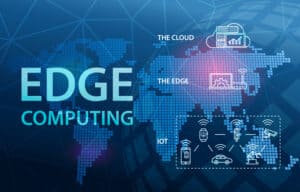
We’re beginning to enter a new realm where businesses need to address business challenges at scale. That often requires the edge that can process, analyze, and act upon near real-time data across business units and operations.
On behalf of Dell Technologies, Vanson Bourne conducted a recent research and analysis study (November 2022), “The Journey to the Edge: It’s Closer than you Think,” and discovered that 97% of IT and OT decision makers expect that their organizations would be negatively impacted if they did not move their operational activities to the edge. The study further found that while 94% of organizations are at least planning to use edge solutions, only 10% are in production in an advanced stage to do so. The statistics, while surprising, make sense. When it comes to trying to scale edge deployments, companies are faced with many complex challenges.
RTInsights recently sat down with Alison Biers, Director of Edge Solutions at Dell Technologies. We discussed edge opportunities, edge challenges, what makes edge environments and deployments different, and how to simplify matters and make it easier to realize the benefits of edge. Here is a summary of our conversation.
RTInsights: How is the edge being used?
Biers: When I think about the edge, it ultimately begins with our customer trying to address an important business issue. It could be a farmer out in the field who is trying to accurately water and monitor plants. It could be a manufacturing facility trying to ensure product quality or that production lines are running efficiently while avoiding unplanned downtime. Regardless of the industry, edge adoption begins with what our customers are trying to achieve.
To date, customers have been deploying solutions to address point problems. We’re beginning to enter a new realm where businesses need to address business challenges at scale. That often requires the edge that can process, analyze and act upon near real-time data across business units and operations. The edge is the new competitive advantage.
Watch Now: Dell Technologies Edge Solutions (Video)We believe that in the next decade, the edge will be the defining architecture that drives business growth. Two leading analysts support this perspective. Gartner, Inc. forecasts that 75% of data processing will be outside the traditional data center or cloud by 2025. IDC estimates that by 2024, edge applications will increase by 800% to meet rising customer expectations and business needs. The edge is becoming an even more crucial part of the computing continuum.
RTInsights: What are some of the inherent networking and data management challenges businesses face when deploying edge computing applications?
Biers: I have seen firsthand that the benefits of edge – when designed and deployed properly – far outweigh the challenges. However, knowing the challenges upfront helps our customers reach better outcomes. The challenges include:
- Latency. Today, seconds matter. The edge is designed for low latency since it’s located where the data is created. However, if that data needs to be sent back to a cloud or your core data center, latency may mean it can’t make the round trip in time. Proper edge design and deployment can help counter this challenge with speed so that you can capture your data fast enough for it to be useful.
- Security. Security is a concern for many of our customers. The elevated levels of cyber vulnerability, together with a rising number of edge deployments, make end-to-end security important. Using zero trust methodology and secure supply chain practices helps to mitigate security concerns.
- Integration and scaling. Our customers need help figuring out how to integrate their existing piecemeal infrastructure to work with the edge. We recently announced Project Frontier to help accelerate edge deployments for customers who get stuck on this challenge. Project Frontier is an industry-agnostic, open software platform designed to work with any OT Software/IoT framework, device, or system. It is designed as a “plug and play” solution, making it easy for customers to use.
- Site-specifics. Site conditions can present edge challenges. That’s because customers have diverse environments that vary, for example, in temperature, humidity, dust, vibration, and available space. If you think about a retailer deploying an edge stack, they may need to put it in a closet to manage within a site’s space constraints. These site conditions determine which components and solutions will best meet our customers’ needs.
The capability to centrally deploy and lifecycle manage infrastructure and applications anywhere your edge is needed is key, but it’s also complex. Organizations must think about and manage all of these issues, build a solution that works and then do it at scale. That’s where Dell can step in.
RTInsights: How does Dell Technologies help address these issues and simplify the edge?
Biers: Why Dell at the edge? We have the broadest edge portfolio, including edge-optimized software and hardware. We have a global ecosystem of partners and a supply chain ready to help empower our customers with simpler, secure edge deployments, global support, and total freedom of choice so that they can focus on maximizing business impact! Ultimately, we are helping customers get more creative so they can deliver business outcomes and obtain a competitive advantage.
Not only are we delivering innovation in our product portfolio, but we are also delivering edge vertical solutions. Some of our recent edge solutions include Dell Technologies Validated Design for Manufacturing Edge and Dell Technologies Validated Design for Retail Edge. As I mentioned, we also just recently announced Project Frontier. This initiative will deliver an edge software platform that simplifies operations, optimizes edge investments, and secures your edge estate. I touched on this a bit above, but beyond our portfolio and solution mindset, Dell is unique in the fact that we bring global scale and footprint, our renowned capability for support and services, and the ability to help consolidate what can be a very complex ecosystem — and streamline that for customers.
These capabilities work together so that we can better help customers simplify their edge.
RTInsights: Can you give some examples/use cases of success?
Biers: A great example is Duos Technologies. The edge helped a railroad company with trains going through the middle of the Canadian outback in subfreezing temperatures. The company needed to do ongoing safety checks that involved routing trains off the track to perform inspections. This check required two people and took about eight hours. After that, if everything was fine, the train could get back onto the track and continue on its way.
The railroad company employed new technology to completely re-engineer these safety checks. Using a computer vision solution and a ruggedized data center built right over the top of the track, safety inspections were conducted as the train passed through at full speed. In case any issues were detected, the solution was deployed at a location that allowed the train to be directed off the track a few miles past the inspection point. Just think about the difference this edge solution is making. Now the train can get to where it’s going faster if there’s nothing wrong with it. You no longer need two people out there for eight hours trying to inspect it. It’s a game-changer.
From a retail perspective, a lot of customers are using the edge to help to reduce their losses. For example, they’re increasing their theft prevention efforts by instituting self-checkout, where you’re able to see what customers are checking out and make sure there is a match with the price that comes up on the screen. Some retailers are looking to edge as they think through what the next-generation retail experiences will be for customers. The goal is to deliver superior customer experiences and remove friction wherever possible, such as providing edge-enabled, smooth checkout experiences with Just Walk Out technology. Lowes is a great example of a retailer leading the way at the edge.
[Sponsored] Creating Intelligent Retail Experiences. Learn MoreThese examples show how we’re bringing intelligence and innovation to the edge and helping to simplify the edge to improve business outcomes. Ultimately, that’s what it’s all about for our customers.
RTInsights: Any other points we should talk about?
Biers: We’ve been helping customers build edge solutions for over 20 years and doing so quite successfully. One of our biggest success stories at the edge is our OEM group. Dell has been the #1 OEM Solutions Provider Worldwide Since 2016. With this strong foundation, we’re able to really offer ways that make it easier for customers to deploy and scale. We’re able to help customers get more creative so that they can attain a competitive advantage and achieve things that perhaps they didn’t know were possible before.
For example, we recently sponsored a trip to send a National Geographic Explorer to Antarctica. The focus of the trip was to identify ways to reduce ocean plastics. As we were talking to the team about ocean plastics, they were saying, “We really don’t have a way to measure ocean plastics because you can’t see them.” But that might be an area where, perhaps with the capability of computer vision and advanced cameras, they can do something that they weren’t able to before. You can learn more about the trip here.
To me, that’s what is so exciting about the edge, helping customers do things they never imagined possible or overcome challenges they didn’t know they could solve. You can really get creative with edge technology, and we love to innovate collaboratively with our customers and reinvent possibilities. As a company, you’ll see us continue expanding from products that help customers design, build, and manage edge solutions to additional solutions that help them simplify their edge. And looking to the future, we’ll continue to build things that are going to help customers scale further as they look to do more and more at the edge.







